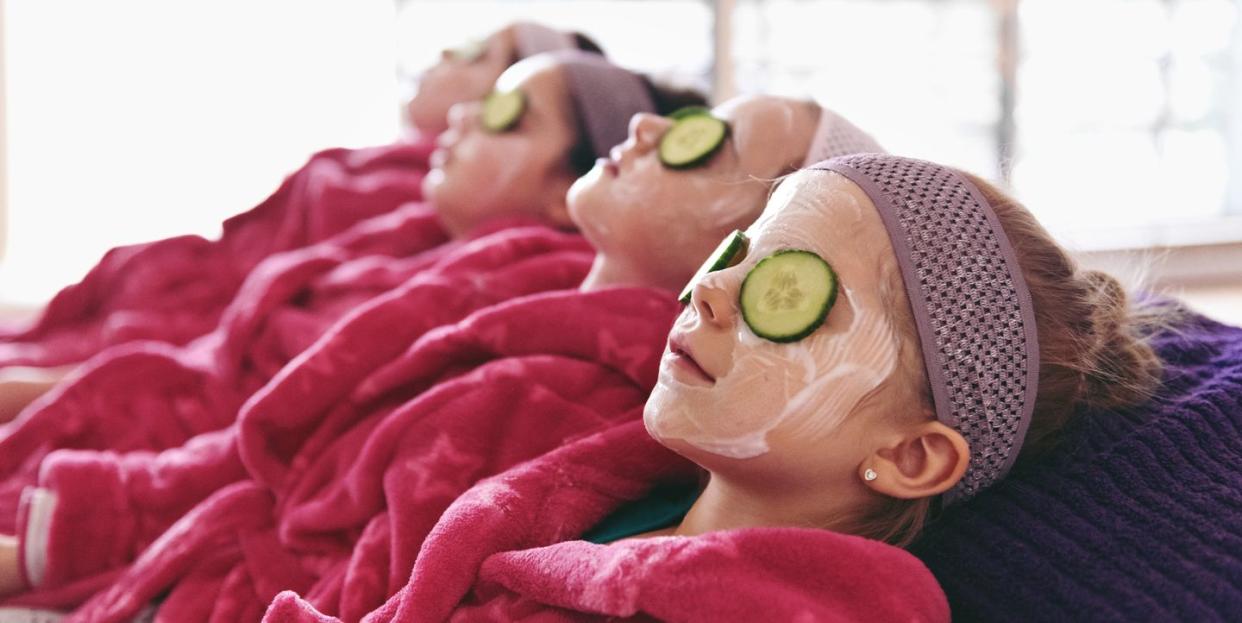Mommy, What's La Mer: Is It Safe For Kids and Teens to Use Adult Skincare Products?

Growing up, I thought my mother’s vanity was vast, yet it was filled entirely with makeup and Shalimar, apart from two skincare products: Pond’s cold cream and a yellow cube of Clinique Dramatically Different Moisturizing Lotion. Her tastes were classic and minimal—and, for the record, she still has fantastic skin.
But in the age of selfies and K-beauty, routines are rarely so streamlined, for mothers or for their skincare-curious children. “Teenagers used to rely on a dermatologist for their skin, but there’s so much more awareness about doing the work at home and really being diligent,” says famed Austin aesthetician Renée Rouleau.
We are all armed with more knowledge, more reviews, and maybe more confusion than ever before. So although a teen can look to YouTube for most cosmetic suggestions, the lure of the parental medicine cabinet remains. Here, we parse what’s fair to share and what you should keep for yourself.
The Products Everyone Can Use
No matter your skin type or age, there are universal saviors. First up: a gentle wash. “I share CeraVe with my daughter,” says New York dermatologist Marnie Nussbaum of the iconic drugstore cleanser. She also recommends daily sunscreen for any age, ideally mineral-based and SPF 30 or higher.
There’s also a case to be made for a basic, lightweight moisturizer, like calming, plant-based Doctor Rogers Restore. That’s pretty much all a teenager will need; for more mature skin, it can be a solid bookend to a routine that has other serums in between. “Skin cells are like fish,” Rouleau says. “They need water to live. The biggest thing for the health of the skin is keeping the barrier intact and keeping moisture in.”
Retinoids, either prescription or over-the-counter, can be used for acne or lines (and a million other skincare woes). The goals for using them may be different based on your age, and the right formula will be too. “To target acne, you want something more medicinal and non-comedogenic,” says Nussbaum. “For wrinkles, you want something more penetrating and emollient.”
The same goes for exfoliation: Light acids like lactic and glycolic can be highly beneficial for all skin types, and although “younger skin is thicker, it can be more sensitive to harsh chemicals,” Nussbaum says. “Even though the dermis is thinner in older skin, the epidermis is thicker and harder to penetrate.” Physical, grainy scrubs aren’t great for anyone, especially those with younger skin.
Just For Grownups
We simply don’t need skincare heavy hitters when we’re young, as most of them are meant to repair environmental and intrinsic damage, reanimate collagen and elastin production, and target specific areas like the eyes and neck.
“I have my vanity out in the open, and she steals constantly,” says electrical aesthetician and ZIIP founder Melanie Simon of her 14-year-old daughter. “She’ll go through a hair product in two weeks, and I’ll have mine for two months.” But it’s not just quantities she’s trying to control. “I want to keep her away from things like aggressive cleansers that are going to break her out.” (Full disclosure: I too take plenty of skincare from Simon, as I work with her on ZIIP.)
Of this spring’s debuts, there are many you’ll want to keep for yourself: -Omorovicza’s the Cure is a nine-day skin treatment with a name that invokes a full-body European detox ritual. “But with this,” says the brand’s co-founder Stephen de Heinrich, “you can have coffee and alcohol and still get the benefits.”
The regimen involves three days of a mandelic and glycolic peel, three days of re-mineralizing the skin and increasing circulation with ginseng and caffeine, and three days of rich, nourishing oils, including those of Barbary fig, kahai nut, and chia seed. Intensive serums for brightening (like Sisley Phyto-Blanc Bright Activating Serum) and damage repair should be in the for-your-skin-only category, as well as those formulated specifically for the neck and eye area.
While some formulas for mature skin are simply richer, others are packed with active ingredients, says Rouleau, who recommends alternating between one or two serums and a retinol to keep skin in shape, just as you do workouts for different parts of the body.
Great for Teens
Technically, there aren’t any products that teens use that adults can’t. But there are items the young gravitate toward: mattifying lotions for oily skin, spot treatments for pimples, and anti-acne face wash. “I want my own cleansers that are better for my skin,” says Phoebe Sinnott, 13, of Boston. She and her mother don’t share any skincare products (her mother laments that “she thinks I have tough skin”), although lip balms and glosses end up being shared, plus the occasional (not approved) eyeliner, “because that’s what I normally steal from my mom.”
There are a few teen-specific lines cropping up, including Florence by Mills, from Stranger Things actress Millie Bobby Brown, and Stryke Club, which was created specifically for teenage boys by four moms, one of whom, Sheilagh Maguiness, is a -Minneapolis-based pediatric dermatologist.
“For a lot of pre-adolescent and adolescent boys, hygiene isn’t their first priority,” she says. Getting them to use a daily face wash that “addresses the antimicrobial needs of teen skin” is key. It’s a low bar, but the message is: Keep it simple, but use something, not nothing.
Other teens take a more sophisticated approach, with a desire to treat preventively. “There’s no downside to starting early in skincare,” says de Heinrich, whose 13-year-old daughter is a fan of his and his wife’s brightening and hydrating Omorovicza Silver Skin Saviour Mask. “But why would you try to resurface wrinkles if you haven’t got them? Common sense is really quite useful here.”
This story appears in the May 2020 issue of Town & Country. Subscribe now
You Might Also Like
